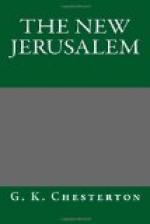Nobody can do justice to these cults who has not some sympathy with the power of a mystical idea to transmute the meanest and most trivial objects with a kind of magic. It is easy to talk of superstitiously attaching importance to sticks and stones, but the whole poetry of life consists of attaching importance to sticks and stones; and not only to those tall sticks we call the trees or those large stones we call the mountains. Anything that gives to the sticks of our own furniture, or the stones of our own backyard, even a reflected or indirect divinity is good for the dignity of life; and this is often achieved by the dedication of similar and special things. At least we should desire to see the profane things transfigured by the sacred, rather than the sacred disenchanted by the profane; and it was a prophet walking on the walls of this mountain city, who said that in his vision all the bowls should be as the bowls before the altar, and on every pot in Jerusalem should be written Holy unto the Lord.
Anyhow, this intensity about trifles is not always understood. Several quite sympathetic Englishmen told me merely as a funny story (and God forbid that I should deny that it is funny) the fact of the Armenians or some such people having been allowed to suspend a string of lamps from a Greek pillar by means of a nail, and their subsequent alarm when their nail was washed by the owners of the pillar; a sort of symbol that their nail had finally fallen into the hands of the enemy. It strikes us as odd that a nail should be so valuable or so vivid to the imagination. And yet, to men so close to Calvary, even nails are not entirely commonplace.
All this, regarding a decent delay and respect for religion or even for superstition, is obvious and has already been observed. But before leaving it, we may note that the same argument cuts the other way; I mean that we should not insolently impose our own ideas of what is picturesque any more than our own ideas of what is practical. The aesthete is sometimes more of a vandal than the vandal. The proposed reconstructions of Jerusalem have been on the whole reasonable and sympathetic; but there is always a danger from the activities, I might almost say the antics, of a sort of antiquary who is more hasty than an anarchist. If the people of such places revolt against their own limitations, we must have a reasonable respect for their revolt, and we must not be impatient even with their impatience.
It is their town; they have to live in it, and not we. As they are the only judges of whether their antiquities are really authorities, so they are the only judges of whether their novelties are really necessities. As I pointed out more than once to many of my friends in Jerusalem, we should be very much annoyed if artistic visitors from Asia took similar liberties in London. It would be bad enough if they proposed to conduct excavations in Pimlico or Paddington, without much reference to the people who




